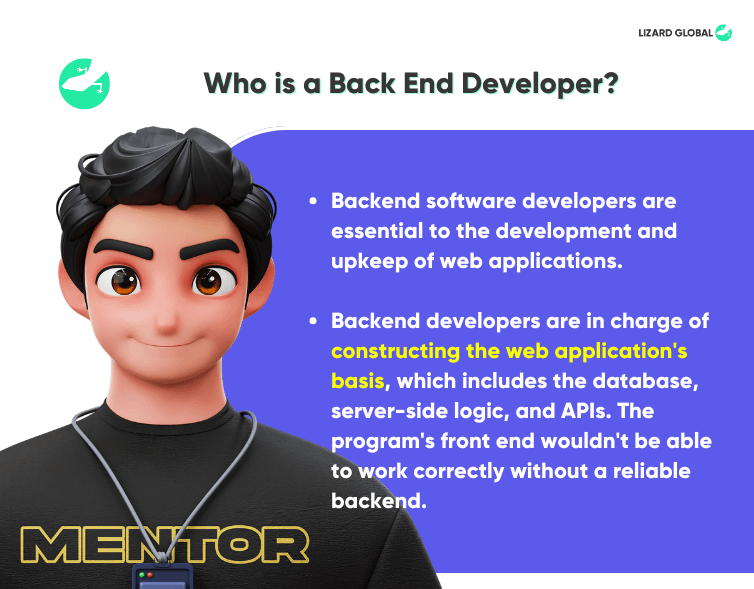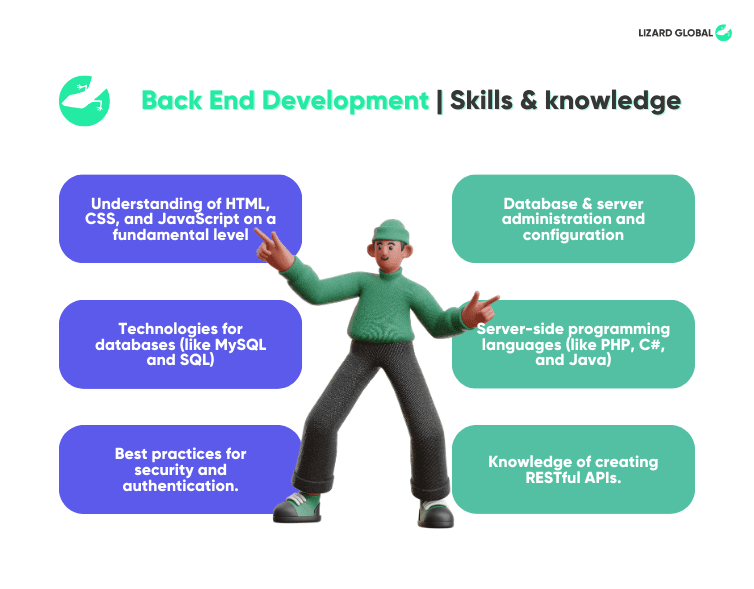How Much Do Back End Developers in the US Make (& More!)
Get the latest updates about our blog posts.
Subscribe so you don’t miss out!
Follow Lizard Global on Facebook, Instagram, and LinkedIn.
Frontend and backend concepts can be difficult to understand if you're not a developer or engineer. When you factor in all the frameworks, programming languages, APIs, and libraries that developers use to construct apps, things may get rather confusing.
But, what if we told you that the fundamentals of back-end development and the different parts of a typical "software stack" can be understood without writing any code? In fact, whether you're the CEO of a tech firm, a hiring manager, a salesperson, or a product manager, knowing your way around it is helpful.
We've compiled a series of articles that explain some essential concepts in a way that non-developers can comprehend in order to help you become an expert in everything related to back-end development. Along with learning what server-side scripting is and what back-end engineers do, you will also get insight into senior backend developer skills, their roles and responsibilities, how much backend developers make in the US, and so on.
Without further ado, let’s start!
What is Back End Development

Tasks performed during the execution of programs on the web are referred to as "back end development." Backend development tackles server-side web application functionality and integration as well as tasks like defining APIs, building libraries, and interacting with system components in place of frontend development, which concentrates on customer-facing services and programs. Backend software engineers create the code that enables database and application communication. Backend programmers, especially senior backend developers are responsible for looking after and maintaining a website's back end, which includes databases, servers, and apps. They have control over what you cannot see.
We have a specific blog post that talks about frontend and backend in app development from the technical point of view. If you’re interested in reading more about this, let me redirect you here.
Who is a Back End Developer?

Backend software developers are essential to the development and upkeep of web applications. The backend of an application needs to be well-designed in order for it to operate effectively and reliably. Backend developers are in charge of constructing the web application's basis, which includes the database, server-side logic, and APIs. The program's front end wouldn't be able to work correctly without a reliable backend.
Additionally, a backend developer must guarantee that the application is secure, scalable, and able to handle heavy traffic. The backend software engineer is also in charge of improving the application's performance, which is essential for a seamless user journey.
Skills needed as a Back End Developer
Let's distill these concepts into a list of skills necessary for a back-end developer now that you are aware of what back-end programming includes.

- Understanding of HTML, CSS, and JavaScript on a fundamental level.
- Having practical experience with back-end development (including database and server administration and configuration).
- Server-side programming languages (like PHP, C#, and Java).
- Technologies for databases (like MySQL and SQL).
- Best practices for security and authentication.
- Knowledge of creating RESTful APIs.
Other common skills for Back End Development
- Working knowledge of frameworks like Larval for PHP and Django for Python.
- The capacity to create top-notch unit tests.
- Any skilled full-stack developer must also have a solid understanding of algorithms and data structures.
- Understanding security issues is crucial because each layer has its own weaknesses.
- Should be aware of the variations between various distribution platforms, such as mobile and desktop.
- A basic understanding of frontend technologies like HTML and CSS is preferred.
- Being familiar with session management in a distributed server scenario.
Roles & responsibilities of a Back End Developer
Designing, developing, and maintaining the server side of online applications is frequently the responsibility of back-end developers. The following are the primary duties and tasks of a back-end developer:
1. Creating the structure and logic for the server side of web applications
Part of a backend developer, especially a senior backend developer is designing and implementing scalable and reliable server-side architectures. This requires designing and implementing infrastructures that are scalable, efficient, and reliable and can handle a lot of traffic and data.
2. Writing server-side code
Back-end developers are in charge of creating server-side code in scripting languages like Python, Ruby, Java, or PHP. Additionally, to speed up development and enhance the quality of the code, they could make use of frameworks like Node.js, Django, Flask, or Laravel.
3. Creating and managing databases
Back-end engineers need to have a working knowledge of databases like MySQL, PostgreSQL, or MongoDB. They also need to be able to create and maintain databases that are dependable, secure, and efficient.
4. Integrating frontend and backend functionality
Back-end developers collaborate closely with front-end developers to make sure the server-side and client-side of web applications communicate with each other in a seamless way. In order to do this, back-end features like APIs, databases, and authentication systems must be combined with front-end interfaces like HTML, CSS, and JavaScript.
5. Providing and maintaining API documentation
Back-end developers are in charge of documenting the APIs they design, which includes providing comprehensible and concise documentation that makes it simple for other developers to understand and utilize their code.
6. Testing and debugging code
Back-end engineers need to be skilled at testing and debugging their code to make sure that it operates as intended and is free of bugs and vulnerabilities.
7. Security and data privacy best practices
Back-end developers must be well-versed in security and data privacy best practices in order to implement secure authentication protocols, encryption, and other security measures to protect user data.
8. Knowledge of current technical breakthroughs
A back-end developer's ability to employ the most recent programming languages, frameworks, and technologies in their work depends on their knowledge of current technical breakthroughs.

Example of Back End Development roles
The term "back-end development" applies to the server side of all applications, not simply websites. Consequently, having a rudimentary understanding of how to develop an application's back end might be useful for a variety of different vocations. Let's look at the roles that are most common in back-end development:
1. Back-end web developers
Their primary responsibility is to create a website's back end. They are in charge of creating and upholding the server, database, and business logic of a website.
2. Full-stack developers
Full-stack developers are proficient in both the frontend and backend of a technology stack. They might be the only developers creating a Minimal Viable Product (MVP) on tiny projects. They assist in connecting an app's front and back ends and act as team leads on larger projects.
3. Java Developers
Programmers who specialize in Java are in high demand in the enterprise app sector, working on everything from desktop programs to websites.
4. Computer programmers
This may be a different Java developer position or one using any of the other languages we mentioned previously, depending on the job description. Jobs in software development are frequently related to desktop programs and other non-website applications.
Back End Developer salary in US

The average annual backend developer salary in US as of August 22, 2023, is $119,704. In case you need a quick pay estimator, that comes out to about $57.55 per hour. This amounts to $2,302 every week or $9,975 per month.
Want to know what are the best development companies in the USA? Check out this list!
Become a Back End Developer in the Netherlands or Malaysia
Backend developers are the second most popular role among software engineers in the Netherlands, behind full-stack developers, with a quarter of them identifying as such.
If you share the same enthusiasm for digital transformations as we are and is looking for an internship programme or a flexible cross-functional role in a youthful, imaginative, and international company? If so, you might be the ideal applicant. Check out the positions we currently have open below, and welcome aboard to the Lizard Family!





